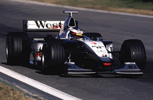The Shark Fin isn't the most desirable looking, but that it nothing compared to the fat nose at the front. But hell if it's fast who cares?
Im loving the new Renault livery, it certainly ain't dull. Will require a merchandise spending spree for myself

Technical analysis of the Renault R29
By Craig Scarborough Monday, January 19th 2009, 12:49 GMT
Almost immediately after Williams unveiled their new car in the Portuguese pitlane, Renault rolled the R29 in front of the gathered media.
Striking with both a new livery and an aggressive shape, the new car is a departure for the team. Again, the most apparent feature is the nose treatment, but also the extraordinary sidepod exits.
The new nosecone arrangement takes some ideas from last's year scalloped undernose and applies them to the FIA neutral middle wing element.
In order to make this fixed aerofoil section add downforce, Renault have added a bulged nose area just above and behind it, taking the nose to its maximum width and filling in the space behind the front wing mounts.
In doing this, the team have chosen a Venturi section to create low pressure and thus downforce over the front axle, an area that might otherwise create lift.
Like all teams bar McLaren, a two-element front wing then mounts the nose, with quite large endplates aimed at diverting the airflow off the front face of the tyre to reduce drag.
Around the front of the sidepods, Renault have yet to fit a bargeboard or pod wing, while their front splitter treatment is typical of the other 2009 cars, with a lip running on the edge of the splitter. Renault maintain their practice of extending the vertical splitter between the floor and the raised nose as far forward as the front wheels.
For the balance of the sidepods, the R29 features deeply undercut sidepod fronts, with extra cooling inlets for the Magneti Marelli KERS system. Then the sidepods fold into the coke bottle area to form an extreme shape for the cooling exit.
As there is no cooling exit on the top part of the sidepod (although the rules allow for one), the exit area is entirely made up by the widening of the coke bottle shape nestling in between the rear suspension. More cooling outlet area is afforded by a exit atop the gearbox.
Above this area Renault have fitted a shark fin top body, like Toyota did on Sunday.
At the very rear of the car the diffuser and rear crash structure follow normal practice, while it appears the rear damper layout has been changed to alter the orientation of the torsion bars, thereby mounting the dampers lower down inside the titanium gearbox casing.
http://www.autosport.com/news/report.php/id/72866_____________________________________________________________________
Technical analysis of the Williams FW31
By Craig Scarborough Monday, January 19th 2009, 12:37 GMT
At the first test of the year, Williams unveiled their definitive 2009 car, the FW31.
Having already run a 2009 wing and diffuser package as well as their flywheel-based KERS system in winter testing, the team are ahead on their development for 2009, hence their car appears simple, but very well detailed.
It strikes similar design chords with other cars seen so far, but with a striking nose treatment and shapely sidepods.
The most immediate feature when looking at the new car is the pelican-billed nosecone. The bulged undernose shape sits above the FIA-mandated central wing section which, along with the two strakes along the side of the nose, encourages low air pressure under the nose to add downforce.
Beneath the new nose is the front wing, which is quite well developed as to be expected from one of the first teams to run a '09 wing package.
The wing's outer spans drop either side of the FIA central template section and kick up noticeably at their tips. This step between the different wing heights is separated by a fence under the wing, which keeps the pressure different between the two sides.
As with most of their cars, Williams use a single element flap that is adjustable, with the six degrees of movement marked with white lines on the endplate. These sleek endplates finish the front wing package, with a lateral plate to send flow around the wheels. Mounted to the endplate is a cascade element to add more downforce.
While the nose grabs the attention, the sidepods are a logical take on the demands of the new rules. Following BMW Sauber's interim car, Williams take the shoulder line high before sweeping in over the exhaust\cooling outlet to form a very tight coke bottle shape. Cooling at the end of the sidepod is allowed by a narrow exit that tapers out at the floor, aided by another exit above the gearbox.
Teams appear to be split on the adoption of pod wings: Williams have decided to fit their mounting to the axe head on the floor, in close proximity to the small bargeboard. As with McLaren, the splitter beneath the nose features a T-shaped lip to direct the airflow above and below the floor.
One unusual feature of the car is the top body's airbox inlet. Last year, Williams aped Ferrari's design and split the inlet between feeding the airbox and the hydraulics' cooler.
This year Williams have made the top inlet just an engine airbox feed, and now cool the hydraulics via two small scoops inlet into the top of the engine cover.
Williams are well known to have their own KERS technology using flywheels to store the energy,the flywheel mated to a second motor\generator (MGU). When the primary MGU charges the system under braking, the second MGU acts as a motor to put this energy by spinning up the flywheel.
When being used as a power boost, the two MGUs reverse their functions: the second MGU generating power from the flywheel and sending it to the primary MGU to power the rear wheels.
http://www.autosport.com/news/report.php/id/72865









